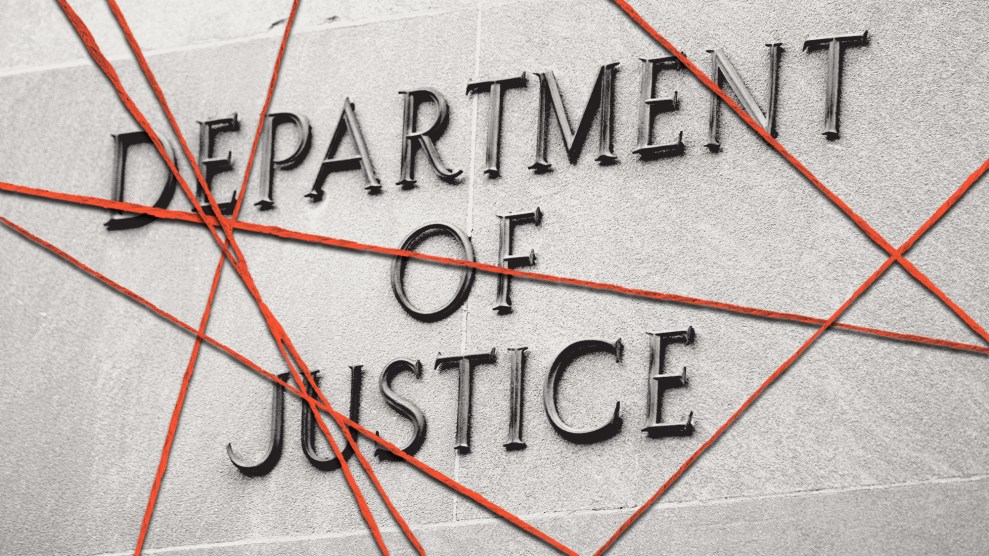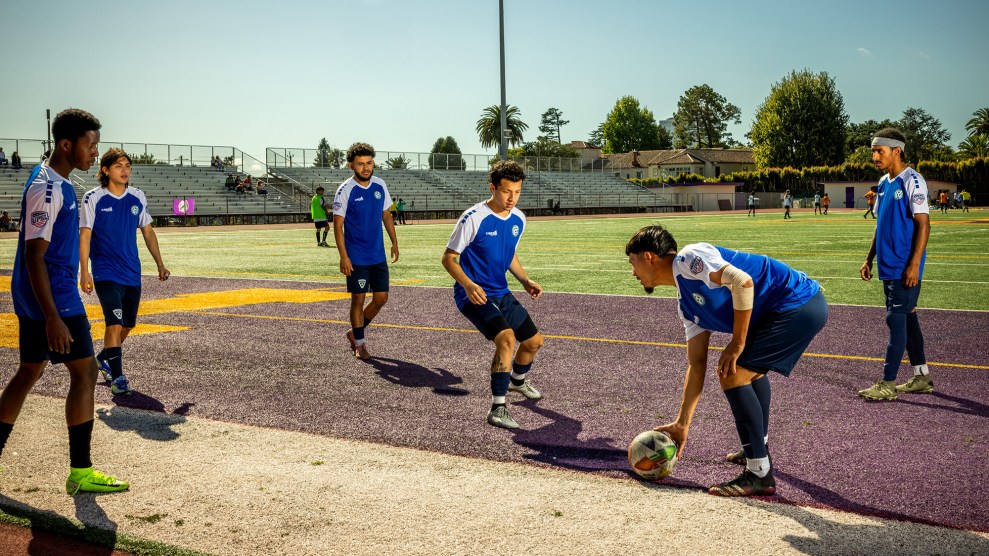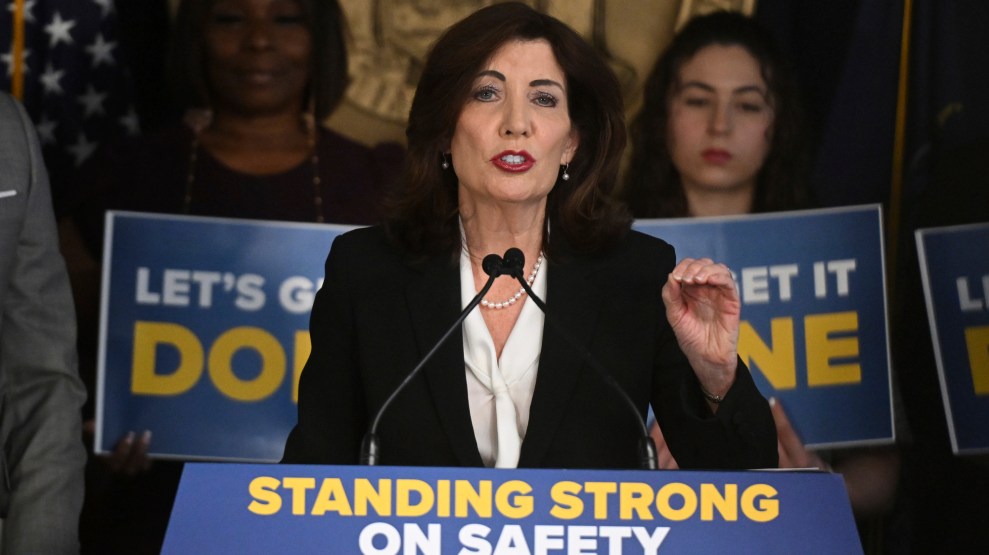
Image: Donna Ferrato
Ernie and Brianna Cushman remember the last time they saw their father. They were home on April 6, 1996, the night he smashed the cellar window, climbed in, and battered down the door into the house. Their mother hid after calling the police, but he found her and threw her to the ground.
When the police officers arrived, 5-year-old Ernie ran out the front door crying, “He’s gonna kill my mommy. He’s gonna shoot her.” The father held the police off with his weeping 3-year-old daughter in one hand and a screwdriver in the other. He pulled the phone from the wall, kicked out a window, and threatened the police with a poker before they finally subdued him. As they took him away, he yelled to his wife that he was going to kill her, there was no place to go, and she had better look behind her because she would never know when or where he was going to appear.
A year later, the children can’t forget. They act it out over and over. Ernie kicks in doors, punches walls, beats his sister, tries to choke her. Brianna doesn’t try to evade him. She knows there’s no use. Males hurt; females get hurt. Kids don’t think this stuff up. They are re-enacting the roles of the two most powerful people in their lives: Daddy and Mommy.
Photographer Donna Ferrato met Ernie and Brianna in February 1997 while documenting programs for troubled families. For more than a year, Ferrato and I accompanied this family as the mother, Brenda Shores, tried to get help for her children through an innovative program near their home in Vermont. We talked with their father, Ernie Cushman Jr., in prison. We followed them to the courtroom while they negotiated visitation. We attended a summer camp with kids for whom dialing 911 is the most important skill they have learned in childhood. Brenda and Ernie agreed to talk to us for the sake of other children who have witnessed violence.
At least 3 million children in the United States live in abusive households. Researchers have found that children as young as 2 years old will emulate violent behaviors, and may come to perceive them as normal. Half of the girls whose mothers are battered will become involved with abusive men. As many as 75 percent of children who see their fathers battering their mothers have behavioral problems. A history of family violence is one of the greatest predictors of juvenile delinquency later.
 “It’s a clear message: Witnessing violence hurts kids,” says Jennifer Barker, author of The Silent Victims: Helping the Children of Domestic Violence. A psychologist and parenting mediator for family court in Middlebury, Vermont, Barker is coordinating a new program, the Addison County Children Who Witness Violence Project, to help children who have grown up with abuse. Barker’s program—which combines the efforts of counselors, courts, and other state and county agencies—is one of the first in the United States to focus on children. In 1996, Vermont, which has cracked down on domestic abusers through prosecutions, received $3.5 million in federal funding for pilot projects to combat the problem. One of the beneficiaries is Barker’s program, and Ernie and Brianna Cushman are among the first group of children to take part in it.
“It’s a clear message: Witnessing violence hurts kids,” says Jennifer Barker, author of The Silent Victims: Helping the Children of Domestic Violence. A psychologist and parenting mediator for family court in Middlebury, Vermont, Barker is coordinating a new program, the Addison County Children Who Witness Violence Project, to help children who have grown up with abuse. Barker’s program—which combines the efforts of counselors, courts, and other state and county agencies—is one of the first in the United States to focus on children. In 1996, Vermont, which has cracked down on domestic abusers through prosecutions, received $3.5 million in federal funding for pilot projects to combat the problem. One of the beneficiaries is Barker’s program, and Ernie and Brianna Cushman are among the first group of children to take part in it.
“Girl’s gotta do what a girl’s gotta do.” Brenda, 29, is singing her favorite tune of the moment. It is May 1997, and she is living in a trailer with her two children. She lost the house because she couldn’t make the payments on her income alone. Her ex-husband is in prison, serving 13 months for domestic assault. She is telling her story, she says, to help “other women out there.” It took her a long time—and a lot of help—to get to this point.
Brenda has a poor memory, the result of a car accident when she was 19 that left her in a coma and in the hospital for several months. While in rehabilitation, she got a job at a convenience store. That’s where she met Ernest Winslow Cushman Jr. He was 27. On their first date they were supposed to go bowling but went barhopping instead.
He later told her that he was married and that he had been in jail for almost killing somebody with a jackhammer. She said she didn’t go out with married men. She got a big insurance settlement for the car accident. He got a divorce. She got pregnant with little Ernie. She paid for half of her engagement ring. They got married. They had Brianna. He drank. They fought. She never said anything about the violence to anyone.
It wasn’t until Brenda got a job working in the kitchen at the Addison County Parent-Child Center that she realized the violence wasn’t normal. She had never been exposed to people like the counselors and teachers she met there, people who considered violence unacceptable. She heard for the first time the stories of other women who had endured—and escaped from—their husbands’ threats, blows, and degradation.
Eventually, Brenda separated from her husband and filed relief-from-abuse orders in court, but she let him come back, over and over, until that night in April. While her husband was awaiting trial, little Ernie told her, “Mom, I’m afraid of Dad. Kick him out.” That was it. Brenda fled to a motel with the children and filed for divorce. While Cushman was serving his sentence, the divorce became final.
“I love him for what he gave me—my kids,” Brenda says. “But I hate him for what he’s done to us.” She says this even though she knows he’s getting out. “He’ll come look for me. Then kill me. Take the kids away. That’s what he’s gonna do.” She’s toughing it out. She keeps mace and red pepper spray under her bed. But, she says, “I’m scared to death. Right now.”
It is the day before Mother’s Day, 1997. Brenda gets up at 5 a.m. to shower, clean the kitchen, pay bills, and then get the kids up. Ernie and Brianna sit at the kitchen table with plates of scrambled eggs. Ernie is an alert, intelligent little boy with an infrequent smile that doesn’t reach his eyes. He is fastidious, artistic, and athletic—the latter to his little sister’s misfortune. When frustration builds, he erupts in rage, and if Brianna is within range, she bears the brunt. One moment the two are happily playing. The next, Brianna needs an ice pack.
 While his mother isn’t watching, Ernie pours a cupful of ketchup and half a glass of milk over his eggs. “It’s gross. I won’t eat it,” he says, throwing a spoonful on the floor. He begins to chase Brianna. She cries. He hits her. She stomps him.
While his mother isn’t watching, Ernie pours a cupful of ketchup and half a glass of milk over his eggs. “It’s gross. I won’t eat it,” he says, throwing a spoonful on the floor. He begins to chase Brianna. She cries. He hits her. She stomps him.
“You’re hurting my life,” yells a frustrated Brenda. “Come on, don’t hit her.” Ernie whines, “I’m hungry. I want French toast.”
Finally, after Ernie insists on wearing pink, slipper-footed pajamas under his clothes, they get in the car and head for Brenda’s father’s place. Brenda, the youngest of eight children in a farm family on welfare, says she remembers her own parents arguing. “But that’s normal for a male and a female,” she says. “Dad, he would yell at us or slap us on the butt.”
In the living room there, Ernie kicks and hits Brianna. She cries. “Crybaby, crybaby, crybaby,” Ernie chants.
“Each tear is worth $10,000,” teases their grandfather. “Come on, I want more tears—$30,000, $40,000.” Ernie beats on her some more, and she screams. “It won’t hurt when you get married,” the grandfather says.
As Brenda gathers the children to leave, Ernie kicks the car door with his muddy foot and refuses to get in. “Come on, Ernie, let’s get rolling,” says Brenda. Ernie stuffs handfuls of mud down her white shirt and smears it in her hair.
As they drive, radio ads talk about Mother’s Day. “What’s one thing you like about Mom?” Brenda asks Ernie.
“Fart,” says Ernie, one of his favorite words these days. “No, come on,” says Brenda.
Ernie considers. “You help me learn.”
 At the Sip ‘n’ Suds laundromat, Ernie kicks the candy machine until it spits out some coins. The girl in charge watches helplessly as he tears around the wooden floor, ramming laundry carts into walls.
At the Sip ‘n’ Suds laundromat, Ernie kicks the candy machine until it spits out some coins. The girl in charge watches helplessly as he tears around the wooden floor, ramming laundry carts into walls.
Brianna longingly eyes a father doing the wash with his toddler. Ernie grabs Brianna’s barrette and tosses it up into the air until it lodges 12 feet up, atop a fluorescent light. A predatory look comes over his face, and he begins circling Brianna. She heads for the shelter of her mother. Ernie follows and kicks her. Then he yanks the pierced earring from her ear. “Ernie’s mean, isn’t he?” says Brianna. “Ernie pull my earring out. It bleed.” Brenda sighs and keeps folding clothes.
“I hate it when he hits his sister,” she later explains. “He’s so cruel and mean. He just whacks her one. Ernie’s gotta learn he doesn’t hit girls or people. How’d he like it if someone did it consistently to him?” Brenda won’t spank Ernie. He’s suffered enough, she says, and she tries not to yell. But that leaves her with empty threats: “We’re going to leave without you” or “You can’t have that candy.” And then she waits for him, lets him have the candy.
The situation is not uncommon, according to a report about violent families published in Family and Conciliation Courts Review. Researchers found that “younger boys were typically difficult, oppositional, and aggressive; they were sometimes manipulative and controlling, especially with their mothers. The mothers, in response, were often passive and ineffectual…. These women ended up becoming as submissive to their aggressive sons as they had been to their abusive husbands.”
 The sibling relationship also follows a familiar pattern. Carla Garrity, a child psychologist who works with children in high-conflict divorces, says that while in most bad family situations siblings stick together, in violent families, sibling behavior tends to mimic the parents’ roles. “Opposite-sex siblings tend to be at more risk to act out exactly what they see their parents do,” she says. “Girls align with the victim, boys align with the aggressor.”
The sibling relationship also follows a familiar pattern. Carla Garrity, a child psychologist who works with children in high-conflict divorces, says that while in most bad family situations siblings stick together, in violent families, sibling behavior tends to mimic the parents’ roles. “Opposite-sex siblings tend to be at more risk to act out exactly what they see their parents do,” she says. “Girls align with the victim, boys align with the aggressor.”
After leaving the laundromat, the family heads to the home of one of Brenda’s high school friends. The friend says she’s heard that Ernie is getting out in two weeks.
“Two weeks?” asks Brenda. They look at the calendar. “This month,” Brenda says flatly. “He’s gonna come after me.”
The sun is setting, and it’s getting dark in the trailer. There is a smell of pigs from a nearby farm. A borrowed car sits in the driveway. Brenda can’t afford to get the family car out of hock since her son smashed the windshield with a slingshot and a rock. He has trashed the trailer, too—smashed doors that won’t lock, broken windows—all but his father’s gun cabinet, now his, which still has pristine glass doors. Brenda sold the guns long ago. Her $889 monthly disability payment from the car accident has to cover rent, utilities, car payments, insurance, and VCR installments. “Sometimes,” says Brenda, “I just feel like I’m going so backwards.”
It is the day after Mother’s Day, and Brenda has received a letter from the state warning her of her ex-husband’s imminent release. She decides to prepare the children. When he first went to prison, Ernie wrote his children a letter that Brenda has never read to them because court orders prevented him from communicating with his children. Now it is time. In the kitchen, where the only light is, Brenda asks Ernie if he wants to hear the letter. He keeps his head down, but nods.
“Hi Ernie, Brianna,” Brenda reads. “Daddy’s sorry he did not write to you sooner, but I am trying to take care of the trouble that I got into. Ernie, you know that Daddy was bad, and when you are bad you have to be punished. So Daddy is away being punished. When I’m a good boy, I’ll be able to see you and Brianna. Daddy learned a lot from being bad, and has a long way to go…. I miss and love you all. Soon, little ones, very soon I’ll be able to see you. Ernie, give Brianna and Mommy a kiss and hug from Daddy. Be good ’cause Mommy got a lot of problems right now like Daddy does, so help her, Ernie and Brianna. I love you. Daddy.”
 Brenda looks at her son, who is determinedly drawing two empty eyes in a face. “Do you know where Daddy is?” she asks.
Brenda looks at her son, who is determinedly drawing two empty eyes in a face. “Do you know where Daddy is?” she asks.
“In jail,” Ernie mutters.
“Do you know why he is in jail?”
“No.”
“He told you why. He said he was a bad boy,” says Brenda, watching Ernie draw ever more frantically. She asks if he wants to send his father a letter.
“That’s what I’m working on right now,” says Ernie.
“Do you want to sign it?” Brenda asks.
“Stop bugging me when I’m drawing!” shouts Ernie.
“Your daddy loves you very much,” says Brenda calmly.
“Stop it, I said.” Ernie slams the table.
“That’s a very nice picture,” says Brenda. “We’re going to get the envelope and the address and the stamp. Can I put Ernie Cushman III on the return address?”
“I can write it,” says the first-grader. “Cursive.”
“Yes, you can. He’d be proud if you wrote it cursive.” She tries to help. He hits her and tells her to stop. Then he asks her to write a word for him.
“Stupid! Stop! That isn’t how you make a five. That’s an ‘s.’ Stupid writer.” Ernie erases his mother’s writing. Finally, the envelope is done.
Brenda claps in applause as her son tries to get the creases of the picture just right. “Good job, sweetie,” she says. She moves on to the next part of the program: the safety plan.
“Your daddy should be out in a few weeks now, and he’s going to want to see you,” she tells Ernie. Brianna dances around the dark living room, just within earshot. “How do you feel about it?”
“Shut up,” says Ernie.
“We have safety procedures. And when I tell you it’s time to go, it’s time to go,” says Brenda. “Ernie, you’re going to help me, aren’t you?”
“I don’t know. I don’t know. Shut up.”
“You know how to use the mace,” says Brenda. “I don’t,” says Ernie. “I usually spray it in my eyes.”
If a child exhibits certain symptoms, according to domestic violence experts, visitations or contact with a violent parent may cause the child further harm. Ernie displays several warning signs: significant physical aggression, devaluation of the victim parent, disrupted school and peer functioning, and self-harming behavior (he bites his toes).
Brenda cranks up the radio, loud, and the family of three dances in the dark. She’s always more afraid at night. “But a girl’s gotta do what a girl’s gotta do,” she says.
 |
| In court, Big Ernie asks why his son sends cards if he’s so afraid. |
A few days later, little Ernie’s picture arrives at the Marble Valley Regional Correctional Facility in Rutland, Vermont. Ernest Cushman Jr., 37, admits that Brenda has reason to fear him. “I did threaten to kill her. Yes, I did,” he says. “I almost put her head through the windshield one night. I was verbally abusive, too. I was drinking all the time.”
He has heard that his son is having trouble in school, that he’s hitting other kids. “I’ve screwed up a lot of lives,” he says. “I know I’ve hurt my kids. Ernie, he’s seen abusiveness.” He blames some of Ernie’s anger on himself, some on the fact that he was “yanked away” from his son’s life. He says, “I don’t want him like I am. I want people to respect him. Not be kicked around like I have.”
He loves his own father, the first Ernest Cushman. His mother ran off when he was a little boy. His first love dumped him while he was in the service. His first wife cheated on him. It’s no wonder he has a problem with trust. Jealousy is why a lot of the fights with Brenda began. “Every time I started drinking, it just popped into my head,” he says. After one fight, he went on a binge for four days. When he started throwing up blood, he quit drinking. “I’m violent when I’m drunk, and I’m worse when I’m sober,” he says. This is a man, after all, with a tattoo reading “Born to be Wild” on his right arm and a long rap sheet of convictions, including assault, parole violation, possession of stolen property, and violation of abuse-prevention orders.
He is taking cognitive self-change classes in prison. “The Violent Offenders Program has showed me what gets me angry,” he says. “I got to make sure I got all this violence out of my system…. It’s not easy to change.” He swings between rage and remorse, one minute calling Brenda a drug user and an unfit parent, the next saying she’s a good mother. (Brenda has no record of drug use and says these accusations are an attempt by Ernie to gain custody of the children.)
“I want two things: my kids,” Ernie says. “What do you think my son is feeling when he’s making cards for Father’s Day in school?” He writes cards to send in response to Ernie’s picture. But before the mail is picked up, he learns that Brenda filed a new relief-from-abuse order, and he is again barred from communicating with the children. He takes his cards out of the prison mailbox. He wants to reinstitute visitation. He swears he’s going to proceed in an orderly way. “You think I’d jeopardize my kids? I screwed up. It won’t happen again. I got my two beautiful kids,” he says. It’s time for lockup, and he returns to his cell.
It is summer, 1997. Little Ernie, Brianna, and a half-dozen other kids are gathering for a summer camp program designed to give them a safe place to express their fears, to help them redirect their anger, and to teach them what to do in emergencies. Ernie dubbed the program “Camp Monster” the first year he attended, in 1996. The children’s histories pour out unbidden. “My dad pushed my mom because he wanted to get his car back.”
“My dad hit Mom with a knife.”
Brianna says, “The cops came to the house. And they took my dad.”
Willow Wheelock and Sharon King listen calmly. Both work at Women in Crisis, a Middlebury-based organization, where they hear many of these same horror stories from the mothers’ perspective. “That must have been scary,” Wheelock says. “When we talk about this stuff, it might make you feel scared or mad or sad. And those feelings are OK.” Wheelock also runs a school program called “Hands Are for Helping, Not Hurting.” One study showed that children who have taken such courses exhibit fewer acts of aggression each day in classrooms than do children who haven’t.
Wheelock led her workshop in Ernie’s school and was impressed by the boy’s intelligence and responsiveness. “He’s got such potential, if it could be channeled in the right direction,” she says. Indeed, in the last few weeks of school, Ernie received stickers for cleaning up, helped another boy learn to read, and won an award for penmanship. Once, when he felt himself starting to lose it, he asked to be sent to the office.
At the camp, another boy of about Ernie’s age goes ballistic, hurling toys, toppling picnic tables, screaming with rage. Last summer, Ernie was likewise out of control. This summer, he is one of the cooperative ones. King says, “He’s a different little boy now.”
 The children draw pictures of their families. Some live with grandparents, some with foster parents. Ernie asks if he can draw silverware instead. Brianna draws a stick figure, then she slashes her pencil across the paper, over and over. “That’s my father in a cage,” she says.
The children draw pictures of their families. Some live with grandparents, some with foster parents. Ernie asks if he can draw silverware instead. Brianna draws a stick figure, then she slashes her pencil across the paper, over and over. “That’s my father in a cage,” she says.
“Why is he in a cage?” asks Wheelock.
“My dad in jail. My father’s dead. Cops shoot him.”
“You feel like your father’s dead? In real life, honey, he’s alive. You had a dream that he died?”
Last night, Brianna says, she dreamed about bears, deer, hunters, that somebody cut her neck, shot her. She says, “My heart is beeping. My heart hurts.”
She draws some more on her paper. “Those are the cops,” she says. “But they need a gun. Can you draw a gun?”
“No, honey,” Wheelock says, “I can’t draw a gun.”
He is out, July 1997. Every time headlights shine through the window at night or the dog barks into the darkness, Brenda thinks it might be him. She has heard he is asking around for her.
Ernie has filed a motion for a hearing for modified parent-child contact. He sits at a table in front of the judge. His ex-wife sits at an adjacent one. The divorced pair doesn’t look at one another. “OK, Shores and Cushman,” says Family Court Judge Matthew Katz, who has had Brenda and Ernie before him many times. “Now I think we’re here to talk about visitation.”
Brenda has written down what she wants to say. “I want our children to have a healthy, safe, and stable relationship with their father. Because of the length of time since Ernie Jr. and the children have seen each other, it’s important to move slowly and cautiously towards visitation,” she reads.
“So Dad hasn’t seen the kids for a year?” Katz asks.
“Sixteen months,” Ernie says.
Brenda interjects: “You can’t talk about his father at all. [Little Ernie] grabs his little sister by the throat and shakes her and punches her.”
Katz asks if Brenda has thought about what to tell her son. “I told him, ‘You’re going to get a letter from your dad, and he may even call you,'” she says. “It’s up to him if he wants to talk, right?”
“No, that’s the court’s decision,” says Katz. “We can’t leave these decisions up to little children.”
Ernie reports that he is working two jobs, going to cognitive self-change therapy and Alcoholics Anonymous. He holds up the picture his son drew and asks why Ernie sent it, if the boy is as frightened of him as his ex-wife says he is.
Judge Katz has a letter in front of him signed by the children’s counselors. It reads, in part: “The children, particularly Ernie III, continue to show fear and apprehension about seeing their father. At the mention of his father, Ernie III will display avoidance behaviors, including hiding, covering his ears, changing the subject, and escalating into aggressive behaviors.”
“I do know Ernie and Brianna were traumatized that night,” says their father, visibly angry. “I realize a lot of what Ernie does comes from what I done. But they are kids.” He expounds on sibling relationships: “It’s not all sugar and spice.”
 Brenda shakes her head. “What the kids have witnessed—they’re really traumatized,” she says. “I understand brothers and sisters act out, but this is way out of limits.”
Brenda shakes her head. “What the kids have witnessed—they’re really traumatized,” she says. “I understand brothers and sisters act out, but this is way out of limits.”
Finally, Katz says, “We’ve got a real problem on our hands. Everybody recognizes it, including Dad, which is good.” The judge proposes that Ernie begin by writing. “Little Ernie likes to draw. Why don’t you draw him a picture, Mr. Cushman?” Katz suggests they reconvene in a month to see how it’s going.
“That’s fine with me,” Brenda says. “Slowly work our way up.” Ernie agrees to the plan.
Jennifer Barker has been sitting in the courtroom, too. It is she, as the parent coordinator, who will hammer out the details. She is bothered by Cushman’s protestations that Little Ernie’s behavior is normal.
In a 1997 Tennessee state study, 65 percent of college students said they had experienced “very severe physical violence” at the hands of a sibling, but only 21 percent said they considered themselves to have been physically abused. Still, the behavior exhibited by children like Ernie is far more aggressive than standard sibling rivalry. “One of the lines to use in distinguishing abuse and horseplay would be to determine if the activity would be expected in a single incident or over time to result in injuries or intimidation,” says Robert Kinscherff, a psychologist with a law degree who helps professionals in both disciplines evaluate family violence at Massachusetts General Hospital and the Boston Juvenile Court Clinic, and who has advised Barker’s Addison County group.
Age-appropriate behavior is another factor, explains Vernon Wiehe, a professor of social work at the University of Kentucky, and author of Sibling Abuse. For example, a 10-year-old boy who viciously destroys his 3-year-old sister’s doll is acting inappropriately—the boy is old enough to know better.
Barker says she gets discouraged. The problems of children from violent homes seem so enormous, and the solutions that courts and therapies can provide so inadequate. “I’ve been working with abusing families for 30 years—time to see generations turn over,” Barker says. “Ernie’s getting a lot here, but if we look at Ernie times a million, a lot of kids are being overlooked. [These kids] are a thousand times more likely to be violent as adults. And we don’t have a clue as to how to fix this problem except to stop the violence in the home.”
But, Kinscherff says, most abused kids don’t grow up to be abusers. Being taught to resolve conflicts nonviolently is important, he says, and if a child is intelligent, as Ernie is, it helps. “It’s not like you’re doomed, but it does present challenges.”
 Summer, 1998. Brenda has replaced her trailer with another, donated to her by a nonprofit organization, and moved it to a nice lot in a trailer park. She has neighbors now, and a job with a cleaning service. Ernie and Brianna have playmates. Their father, however, is back in jail.
Summer, 1998. Brenda has replaced her trailer with another, donated to her by a nonprofit organization, and moved it to a nice lot in a trailer park. She has neighbors now, and a job with a cleaning service. Ernie and Brianna have playmates. Their father, however, is back in jail.
Originally, Ernie lived up to his personal bargain: He moved in with his churchgoing sister and her husband, stopped drinking, and attended all of his meetings. “I got a long way to go, getting their trust back,” he said of his family.” I know they’ve had enough. I’ve had enough.”
He began sending cards and $82 a week in child support. In the fall, the children started talking to him once a week on a speakerphone at the counseling center with their therapists listening in. At first, Ernie didn’t want to speak to his father, but by the third call, it was “good,” the boy reported. “He told me to wear my bicycle helmet.”
This past winter, the children met with their father at the courthouse once a month. But in May, Big Ernie violated his parole by entering without court permission the county in which Brenda and the children live; visitation is now on hold.
 Yet for Brenda and the children, things are looking up. Little Ernie, now 8, is not whacking Brianna, 5, anymore. The three of them are taking tae kwon do self-defense classes together, learning self-control and respect for others. And for the first time since that April night the police came, Ernie and Brianna feel safe enough to sleep in their own room rather than in their mother’s bed. “Hallelujah, baby doll,” says Brenda. The fear has lifted a little.
Yet for Brenda and the children, things are looking up. Little Ernie, now 8, is not whacking Brianna, 5, anymore. The three of them are taking tae kwon do self-defense classes together, learning self-control and respect for others. And for the first time since that April night the police came, Ernie and Brianna feel safe enough to sleep in their own room rather than in their mother’s bed. “Hallelujah, baby doll,” says Brenda. The fear has lifted a little. ![]()
Claudia Glenn Dowling is a senior writer at Life magazine.
Donna Ferrato has been documenting domestic abuse for 17 years and is the founder of Domestic Abuse Awareness, a nonprofit organization that provides fundraising aid to women’s shelters.
Additional reporting by Jimmie Briggs.
| Resources | |
| Battered Women’s Justice Project 4032 Chicago Ave. South, Minneapolis, MN 55407; (800) 903-0111. Child Help USA (child abuse hotline) Domestic Abuse Awareness, Inc. Family Violence Prevention Fund manalive Education and Research Institute (Batterer’s Program) National Clearinghouse for the Defense of Battered Women National Coalition Against Domestic Violence |
National Councel of Juvenile and Family Court Judges 1041 North Virginia St., 3rd Floor, Reno, NV 89557; (702) 784-6012. National Domestic Violence Hotline National Network to End Domestic Violence NOW Legal Defense and Education Fund National Resource Center on Domestic Violence Peace at Home Urban Justice Center |
















